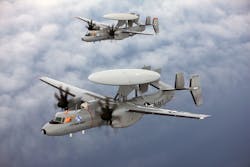Leonardo DRS to provide networking terminals for E-2D aircraft to help combine Navy sensors and weapons
WASHINGTON – U.S. Navy anti-air warfare experts needed an electronics manufacturer to build sensors and weapons tactical networking terminals for the carrier-based E-2C and E-2D airborne early warning aircraft. They found their solution from the DRS Laurel Technologies segment of Leonardo DRS in Johnstown, Pa.
Officials of the Naval Sea Systems Command in Washington announced an $10 million order to DRS Laurel on Friday to build AN/USG-3B Cooperative Engagement Capability (CEC) equipment sets and installation and checkout replacement components.
The CEC is a tactical sensor and weapons network for anti-air warfare that combines information from sensors operating over broadly distributed geographic areas in a common tactical picture for battle groups at sea. CEC avionics improves overall situational awareness, and enables fleet commanders to work closely together to attack enemy forces from long ranges.
The AN/USG-3 is the airborne designation of CEC deployed in E-2C and E-2D aircraft. Other CEC terminals are aboard Navy surface warships; U.S. Marine Corps command posts, aviation command-and-control centers, and surveillance aerostats.
CEC blends sensors and weapons into an integrated real-time network that expands the battlespace; enhances situational awareness; increases depth of fire; enables long intercept ranges; and improves decision and reaction times.
It extracts and distributes sensor information such that the superset of this data is available to all participating CEC-equipped units by fusing the distributed data from shipboard, airborne, composite tracking network ground-mobile units, Joint Land Attack Cruise Missile Defense Elevated Netted Sensor System (JLENS), and coalition partners into one fire-control-quality air track picture.
Related: The coming revolution in commercial avionics data networking
The system uses line-of-sight data distribution to share radar-measurement data among sensors and weapons to create one distributed integrated air picture. It combines surveillance and targeting information such that the combined system is greater than the sum of its parts.
The jam-resistant CEC obtains target track information to form one real-time composite track to help coordinate theater air and missile defense to engage incoming cruise missiles.
On this order DRS Laurel will do the work in Largo, Fla.; Johnstown, Pa.; and Menlo Park, Calif., and should be finished by January 2022. For more information contact DRS Laurel Technologies online at www.leonardodrs.com/locations/naval-electronics-laurel-technologies-johnstown-pa, or Naval Sea Systems Command at www.navsea.navy.mil.
About the Author
John Keller
Editor-in-Chief
John Keller is the Editor-in-Chief, Military & Aerospace Electronics Magazine--provides extensive coverage and analysis of enabling electronics and optoelectronic technologies in military, space and commercial aviation applications. John has been a member of the Military & Aerospace Electronics staff since 1989 and chief editor since 1995.
